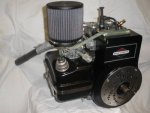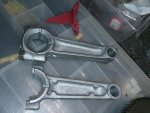JTSpeedDemon
2019 Build Off Winner!
Ok, I'm writing this up, because It's been quite foggy to me before, the differences between a normal Briggs and Stratton 5 HP flatheads and Raptor racing flatheads.
If this thread is in the wrong place, feel free to move it mods.
First off, there were 3 main generations of Raptor flatheads, the Raptor 1, Raptor 2, and Raptor 3(easy to remember, huh?).
The Raptor 1 was essentially a normal flathead, just minus the governor from the factory. They even had bolt on oil dippers, and needless to say, they failed sometimes.
The Raptor 2 is where things started to get more interesting. They got a cast aluminum connecting rod with integrated dipper, and they were also introduced the same year as aluminum bore, dual-bearing blocks.
The Raptor 3 is when Briggs' really stepped up their game. The Raptor 3 got the previously mentioned one piece dipper/rod cap, along with a cast alloy crankshaft and a carbon infused piston. The Raptor 3 was a phenomenal seller and obviously the best for performance and engine life. Raptor 3s also had a different engine block from stock flatheads, with the governor arm area completely plugged off, deeper head bolt holes, and reinforcements in various places.
Some Raptor 3s had steel sleeved cylinders with the block cast around the sleeve, not pressed in. Some Raptor 3s were also aluminum cool bores.
This is Briggs And Stratton's page on their Raptor 3: https://www.briggsracing.com/racing-engines/raptor
But in case the link ever goes bad, I'll copy the main info here.
The Raptor series was discontinued in 1999 due to impending E.P.A regulations.
Here are some specs on the model#133230 8124-01 Raptor:
206 cc displacement
2.5615"/2.5625" cylinder bore
2.438" stroke
6.5/1 compression ratio
And 22 degrees BTDC ignition timing.
When fully pro blueprinted, some claim to be able to extract up to 10 HP from a "stock" Raptor.
Raptors are perhaps the most legendary kart racing engine in the history of karting, so if you get a chance to buy one, get it! A lot of tracks still have a class for Raptor flatheads, so there's also a racing use for it still.
Hopefully this info is useful and I didn't offend anybody.
(Shown below are Raptor 3s)
If this thread is in the wrong place, feel free to move it mods.
First off, there were 3 main generations of Raptor flatheads, the Raptor 1, Raptor 2, and Raptor 3(easy to remember, huh?).
The Raptor 1 was essentially a normal flathead, just minus the governor from the factory. They even had bolt on oil dippers, and needless to say, they failed sometimes.
The Raptor 2 is where things started to get more interesting. They got a cast aluminum connecting rod with integrated dipper, and they were also introduced the same year as aluminum bore, dual-bearing blocks.
The Raptor 3 is when Briggs' really stepped up their game. The Raptor 3 got the previously mentioned one piece dipper/rod cap, along with a cast alloy crankshaft and a carbon infused piston. The Raptor 3 was a phenomenal seller and obviously the best for performance and engine life. Raptor 3s also had a different engine block from stock flatheads, with the governor arm area completely plugged off, deeper head bolt holes, and reinforcements in various places.
Some Raptor 3s had steel sleeved cylinders with the block cast around the sleeve, not pressed in. Some Raptor 3s were also aluminum cool bores.
This is Briggs And Stratton's page on their Raptor 3: https://www.briggsracing.com/racing-engines/raptor
But in case the link ever goes bad, I'll copy the main info here.
- Racing connecting rod with integral oil dipper and larger radius I-beam.
- Soild fuel tank bracket and improved tank to bracket connection.
- Oil impregnated bronze exhaust valve guide for long competition life.
- Revamped carburetor machining for uniform high- flow.
- Redesigned head gasket for torque retention and heat transfer.
- Longer high-strength head bolts for better control of head torque.
- Silicon-beaded crankcase cover gasket for oil control and torque retention.
- Upper retainer controls valve for spring control.
- "As Cast" block, head and crankcase cover reduces combustion deposit and debris collection on internal parts.
The Raptor series was discontinued in 1999 due to impending E.P.A regulations.
Here are some specs on the model#133230 8124-01 Raptor:
206 cc displacement
2.5615"/2.5625" cylinder bore
2.438" stroke
6.5/1 compression ratio
And 22 degrees BTDC ignition timing.
When fully pro blueprinted, some claim to be able to extract up to 10 HP from a "stock" Raptor.
Raptors are perhaps the most legendary kart racing engine in the history of karting, so if you get a chance to buy one, get it! A lot of tracks still have a class for Raptor flatheads, so there's also a racing use for it still.
Hopefully this info is useful and I didn't offend anybody.
(Shown below are Raptor 3s)



